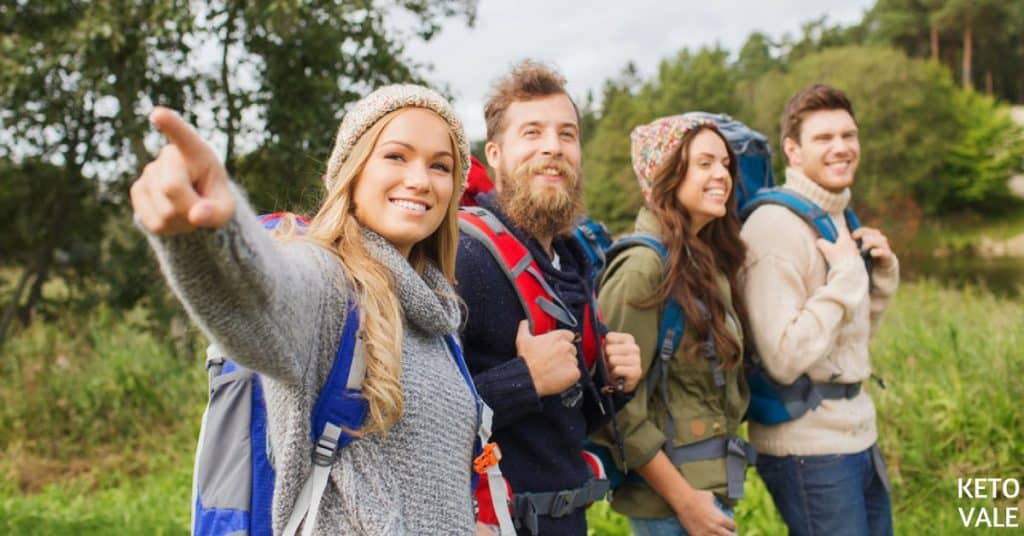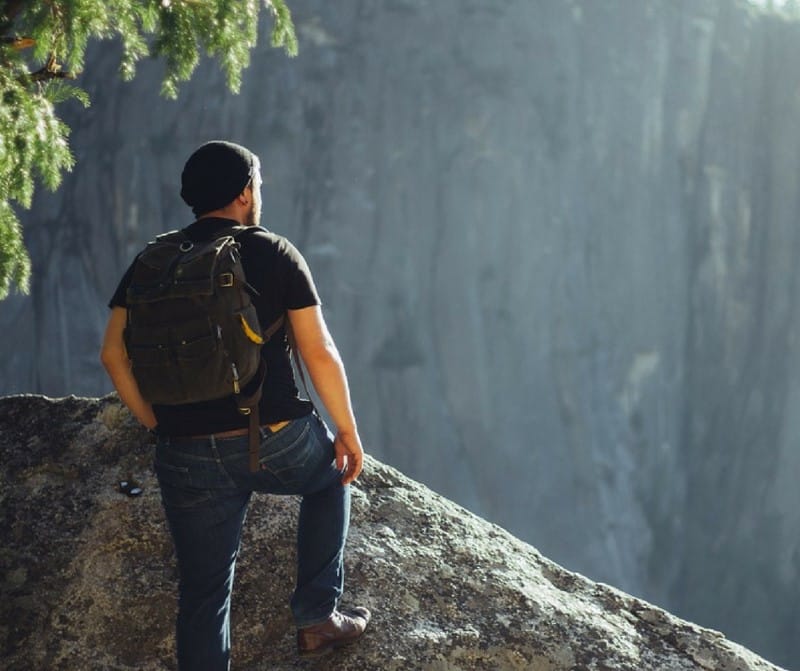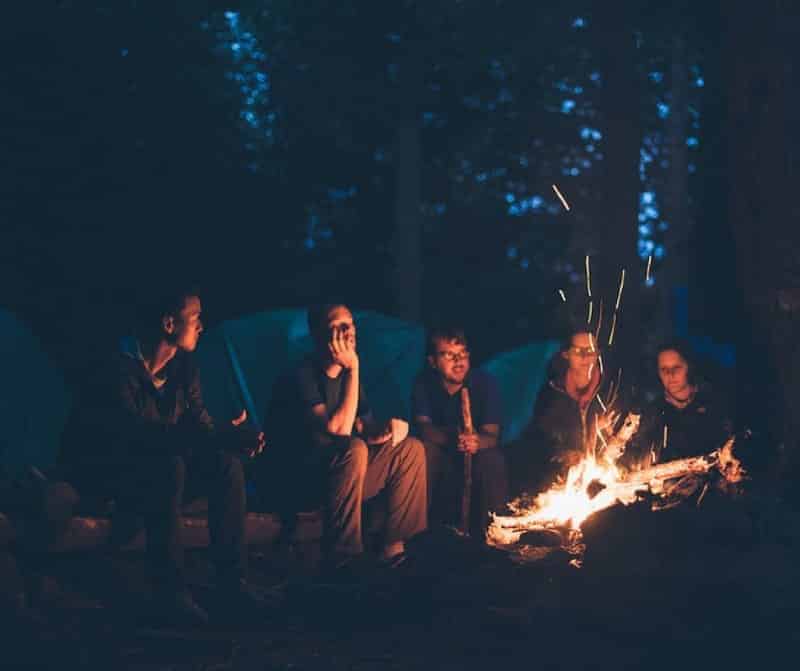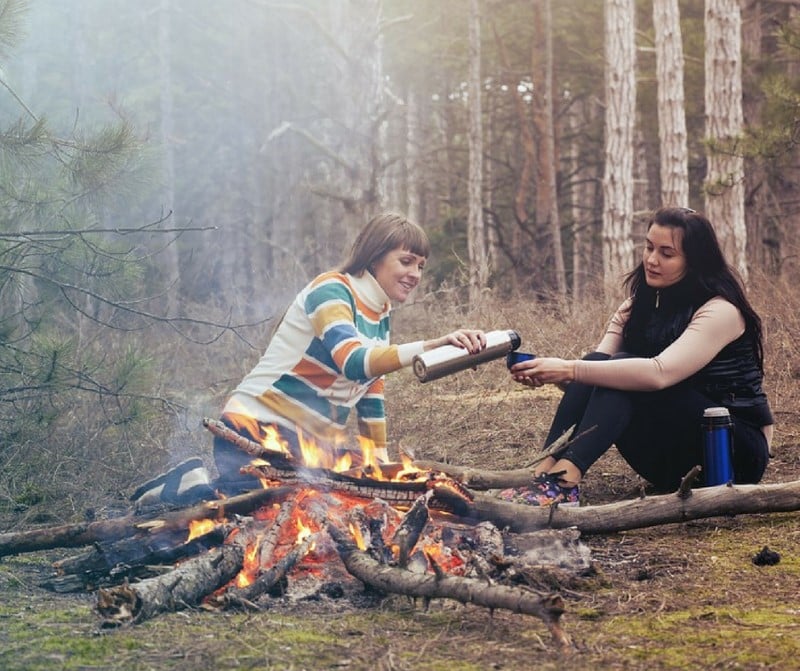Hiking is an amazing way to combine your love for nature and the outdoors with a medium to high intensity physical activity.
It has a lot of amazing benefits:
- it can be a very useful tool in your weight loss arsenal – while on the trail, you’ll be burning lots and lots of calories
- it will improve your endurance and cardiovascular health
- it will help you manage your stress levels
- it will help you build strength in your legs and core (and eventually arms, if you’re using hiking poles).
So, you’re probably wondering – can keto and hiking be combined? Absolutely!
How do you prepare for a keto hiking or backpacking trip? What keto foods should you bring? What else do you need?
Let’s check out all the details.
But before we dive into the practical aspect of it, let’s see the reasons why combining keto and backpacking can be a great idea.
Top 5 Reasons Keto and Hiking Are An Excellent Combination
#1. Once You’re Fat Adapted, Keto Will Significantly Help With Endurance
Chances are if you’re into endurance sports, you’ve heard the term “bonking”, i.e. depleting your glycogen stores and suddenly feeling weak and exhausted, to the point of not being able to continue.
And you know what? Bonking doesn’t exist on keto.
Your glycogen stores are mostly depleted anyway, and even if they aren’t, your body will effortlessly switch to using fat for fuel once you deplete them. And consider this: your fat stores are much bigger than your carb stores.
In fact, they store thousands and thousands of calories of energy, ready to be used if needed, while glycogen stores, even if fully replenished, can be depleted in a day or less, if you’re doing some strenuous physical activity.
#2. You Won’t Be A Slave To Hunger and Carbs
Hiking can be very energy consuming, especially with higher elevation gains or longer distances.
If you depend on carbs for your energy, you’ll often be hungry, and will need to refuel frequently.
If you’re doing keto, however, you’ll notice that hunger is much milder and easier to manage while on the trail, and doesn’t come so suddenly.
You won’t need quick energy in the form of sugar, because your body will be tapping into its own fat stores. Quite neat, right?
#3. Keto Meals Are Lighter Than Carby Meals
In the wild, you’ll be carrying your own food, and if you’re planning on hiking for more than 2-3 hours at once, you know that optimizing the weight of your backpack is essential.
Keto meals will be much more energy-dense, and therefore both more space- and weight-efficient than carb-heavy food.
#4. If You Have Experience With Fasting, You Can Fast Through A Part Of The Hike
We don’t recommend trying fasting for the first time while you’re on the trail, but if you already have experience with it, you can fast through a part of the hike.
Like this, you can save time and have a big, rewarding meal at the end (and a quick snack in between, if needed). For more information on the benefits of fasting, check out our article on the topic (link).
Keep in mind that hiking can be a very intense activity, and if you’re not used to working out while fasted, you should pay close attention to the signs that your body is giving you.
If you’re feeling hungry, weak and tired, or otherwise unwell because of fasting, eat. Don’t be too strict with your fasting hours if you’re hiking – you’re putting your body through lots of physical stress already.
#5. Keto And Hiking Can Be An Excellent Weight Loss Strategy
A strenuous physical activity that burns a ton of calories? Check.
Improved endurance? Check
Decreased hunger? Check.
Utilising your body fat in a super-efficient way? Check.
Do we need to say more?
Of course, calories are still important and you need to make sure you’re eating less than what you’re burning, but your caloric needs while hiking will likely be much higher than usual, while your hunger will probably remain moderate.
While portion control is still important, on the trail you’ll anyway need to portion your meals, so that won’t be too much of a challenge.
And snacking because of boredom will be reduced to a minimum, as you need to remain concentrated, and will be spending your time observing the amazing landscapes that you’ll be going through.
5 Things to Consider Before You Go
#1. Hiking Is Best Done Once You’re Already Fat-adapted, Or At Least Have Passed The Keto Flu Phase Of Your Diet
If you’re already fat adapted, it’ll be easier for you to do longer or harder hikes – you’ll have less appetite and more endurance.
We don’t recommend hitting the trail if you have just started out with keto – the keto flu might slow you down and make things considerably more difficult and less enjoyable.
Instead, give your body at least a couple of days, ideally 2-3 weeks, to adapt to your new way of eating before going on a strenuous hike or a backpacking trip, and you’ll feel much better.
#2. Your Carb Limit Will Probably Be Higher Than Usual, But Don’t Go Crazy On Carbs
Your energy requirements will probably be much higher than usual – hiking can be quite intense, and if you do it over many hours, you’ll burn a lot of calories. This means that small amounts of carbs ingested during (or before) your hike will be instantly used for energy, which will naturally drive your carb limit up.
Don’t go crazy on carbs though, if you want to keep the advantage that keto is giving you – all kinds of food with added sugar, or high-carb fruits, bread, pasta, rice, etc., are a no-no.
If you’d like to use the additional flexibility that the higher carb limit is giving you, opt for a carrot or two, or a few pieces of low-carb fruit.
#3. You Need To Pay Special Attention To Your Electrolyte Needs
Electrolytes are super important on keto, and even more so if you’re hiking. While on the trail, you’ll be sweating a lot, especially if the weather is hot, which means that you’ll be losing electrolytes at a higher than usual rate.
You absolutely need to replenish them in order to feel good and perform well, so don’t forget to take salt, No Salt or a similar salt alternative (for potassium) and magnesium with you.
If you start getting any of the typical symptoms of an electrolyte imbalance, such as a headache, tiredness, muscle cramps, insomnia, it’s likely that your electrolytes aren’t balanced. In such cases, take some salt and magnesium and see how this affects you.
#4. Bring More Food and Water Than You Expect To Need
If it’s the first time you’re hiking on keto, bring more food and water than what you expect to consume. Although keto is an excellent appetite suppressant, you shouldn’t rely on that and risk running out of food while you’re in the wild.
Your body is very good at dealing with physical stress, but you might still end up hungrier than what you expect, or need more water (keto has a diuretic effect, so you’ll be losing more water than usual). So make sure to bring enough of everything – better be overprepared than underprepared.
#5. Hiking Is Tough On The Joints – Collagen And Fish Oil Can Help With That
Hiking, especially when going downhill, can be tough on the joints (knees, ankles and hip joints in particular). In order to help your joints recover, you can take collagen supplements, as well as some fish oil (rich in omega 3 fatty acids).
Both have a positive effect on joint health and can speed up the recovery process. Additionally, make sure you’re getting proper rest on multi-day backpacking trips – your joints and muscles will thank you for it.
What To Pack When Backpacking, Hiking and Camping Trip
Your gear will depend on the terrain, type of weather and length of your trip, so we won’t be concentrating on these. Instead, we’ll look into the things that are specific for a keto hiking or backpacking trip: food and electrolytes.
Food
You have plenty of options for food that is both keto- and backpacking-friendly. Here are some options:
- Meat
Regular meat will only be good for a couple of hours, depending on the temperatures in which you’ll be hiking, but dried meat can last a good while.
You can bring dried meat such as beef jerky (with no added sugar), dried ham, pepperoni sticks, salami, prosciutto, and the like.
You can also cook 1-2 hamburger patties for lunch on the first day, but for longer trips dried and cured meat is your best bet. It’s convenient and lightweight, as the water content has mostly been removed in the drying process.
- Cheese
Hard cheese, such as Parmesan, does just fine if left unrefrigerated, so you can take some with you.
Depending on the weather and on the length of your trip, cheese can be a very convenient high-calorie snack. And you’ll need those calories on the trail.
- Nuts
Nuts are amazing for hiking. They won’t spoil and are very weight-efficient – in just 500 grams of nuts you already have thousands of calories, in the form of good fats and some protein.
Opt for lower-carb types of nuts, such as Brazil nuts, walnuts, macadamia nuts, almonds, etc. You can even make your own trail mix of a few nuts that you like, plus coconut flakes, plus some salt.
- Nut Butters
A bit trickier to transport, but similarly to nuts, they can be an excellent snack while you’re outdoors.
- MCT powder or oil:
Excellent as a quick energy source for the moments you need a boost. MCT powder would be somewhat easier to transport but MCT oil is also an excellent alternative. Check our recommended MCT oil and powder products here!
If you don’t want to spend money on MCT oil, you can just get some coconut oil.
- Hard-boiled Eggs:
Eggs will be good for the first day (or maybe 2, depending on the temperatures), so they’re ideal for one-day hikes.
Boil some eggs in the morning before you go and take them with you – they’re an excellent source of protein and fat, and will provide you with a number of important micronutrients.
- Avocados
If you choose avocados that aren’t yet fully ripe, they can last a couple of days. Excellent source of potassium and good fats.
- Pork Rinds
Although they do take a bit of space, pork rinds can make an excellent high-fat snack. To make them easier to transport, you can crush them.
- Canned fish
Canned fish can last for ages if unopened, but it can be a bit of a hassle, as you’ll need to carry your waste with you – in this case, tins that smell of fish.
If you’ll be able to dispose of your rubbish mid-way (f.e. if you cross a village or go to a hut that has a waste management system in place), canned fish can be excellent for hiking.
As you can see, we’re listing plenty of high-fat options. These will keep you full for hours and will also be easy to transport (each gram of fat containing 9 calories, vs. 4 for carbs or protein).
Nevertheless, if you’re aiming to lose weight, you should still keep a track of your macros and daily calories, as it’s extremely easy to eat big amounts of calorie-dense foods, especially if you’re hungry (which you will likely be, at some point).
Regarding the practicalities of how to transport your food, you can either organize your food by food type, or by meal – decide on a system in advance and stick to it. This will help you save time and minimize the mess. Additionally, you can pre-cut meat and cheese, so that you don’t have to do that while hiking.
If you’re taking oils or nut butters with you, make sure to find a 100% leakage-proof solution for their transportation, and to have 2 systems in place, in case one of them fails (such as screw top containers in a waterproof bag). Getting oil all over your gear will definitely be an unpleasant experience, so make sure it doesn’t happen.
Electrolytes
Don’t overlook electrolytes when hiking on keto – you’ll be sweating more than usual (even in colder temperatures) and you need to replenish the electrolytes you’ll be losing.
Take a good amount of salt (have at least 10 g per day with you), plus No Salt (or a similar salt alternative) for potassium, as well as magnesium supplements.
Electrolytes will be essential for preventing fatigue, cramps and insomnia caused by an electrolyte imbalance. Keep in mind that more extreme forms of electrolyte insufficiency can cause serious health problems, and if you’re out in the wild you won’t have quick access to medical aid, so don’t skim on that.
Water
Of course, everyone who goes hiking should bring enough water with them, but because of the fact that the keto diet has a diuretic effect, you’ll get dehydrated at a higher than usual rate. Take plenty of water with you and make sure to check where (and if) you can refill your bottles on the trail.
Camping Tips
If you’re going to be camping out in the wild, and can bring a cooler, it can help keep meat cool for a longer period of time than just storing it in your backpack. Nevertheless, raw meat spoils faster than cooked meat, so we still recommend cooking it ahead of time. If you’re going to be making a fire, you can still warm it up and make it delicious.
Investing in a good cooler is essential if you’re going to rely on it for long hikes, but keep in mind that no cooler can do the job of a fridge, so portion anything that can spoil into the first part of your trip, and leave the rest for the end.
If you’re bringing a cooler and have a campervan, you can put some ice in it – it needs to be packed well, so that it won’t leak, but it will keep everything cool for much longer. Alternatively, you can freeze 2 or 3 water bottles and put them in the cooler with your food.
If you plan on bringing raw eggs to cook later during the trip, your best bet is to find eggs that have never been washed and refrigerated, as these can be kept at room temperature for a couple of days, if the shell is intact – it actually has a protective layer that prevents them from spoiling.
Unfortunately, eggs in the States are sold washed and cooled, so you might want to look into buying some directly from a farm, where you can ask specifically about these two things.
If you’re going to be camping with a campervan, this makes everything much easier, as you could install a portable refrigerator in it, and won’t be limited by weight.
In this case, you can bring what you would normally eat – meat, veggies, eggs, some low-carb fruits, and so on. Neatly packing everything will help you save space, and you can precook a big part of your meals and keep them in the fridge to reheat before you eat them.
Chances are, if you’re doing a trip with a campervan, you’ll also have access to more food during your trip – you could go to a nearby city or a supermarket to stock up on groceries, or even find a local farm that sells delicious fresh produce.
If you have a portable grill, this can be an excellent solution for your meat, and you can also use it to grill some veggies on it, such as zucchini, eggplant, or cauliflower wrapped in aluminium foil.
All in all, camping while on keto isn’t more difficult or complicated than regular camping, and the food you’ll be eating will be delicious, especially after a long hike in nature.
Our Conclusion
If you’re doing keto and planning to do a hiking or a backpacking trip, there’s absolutely no reason to go back to carbs – on the contrary, keto and hiking make an excellent combination. Your endurance will be better, hunger will be milder and easier to manage, and doing a backpacking trip for a couple of days can even give you that much-needed boost in your weight loss, if you’re stalling.
Have you already gone hiking while on keto? What was your experience?
Do you have any tips you’d like to share with other readers?
Let us know – we’d love to hear from you!










